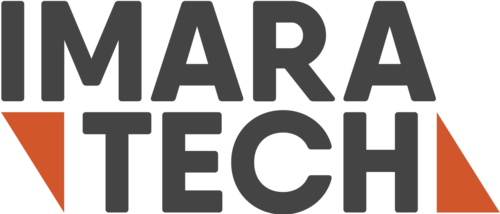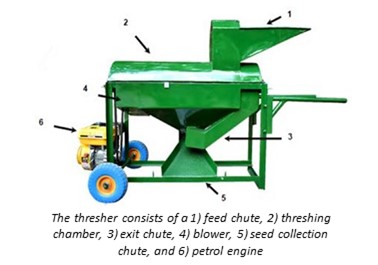Mechanized Threshing Operations
Summary
Threshing refers to the separation of seeds or grain seed from the harvested plant, and this is a tedious operation when performed by hand. Typically, women are assigned this task of hitting piled harvest with sticks until the grain falls loose and, in the case of beans where the whole plant is harvested and dried, it requires about four hours of work to recover 100 kg of seed. This labor requirement is becoming streamlined through increased reliance upon small-scale mechanical threshers able to process 300 kg of seed per hour. These machines are powered by small petrol engines and consist of a feed chute that leads to a threshing chamber where crop residues are separated from seeds in a rotating drum, and then a blower removes smaller residues. Multi-crop threshers are available to process additional crops such as maize, wheat, sorghum, sunflower and pigeon pea. Smaller threshers can be transported to farms by motorcycle and offer business opportunity to local service providers.
About the Solution
Mechanized threshers are power equipment that separate crop residues from seed and grain in a time-efficient manner. Operators feed dried harvest materials through a feed chute, pushing materials into an internal spinning drum where seeds are physically separated from crop residues and then fall through a screen. Remaining crop residues are then expelled through an exit chute. Whole shoots may be passed through the machine rather than pods alone. These chopped materials have further use as organic resources. The seed is passed by a blower that removes finer materials (e.g. dust) that winnows (cleans) the seed, passing through a collection chute that allows the seed to be bagged. Different types of crops may be processed based upon the screen mesh. These threshers are often mounted on wheels and have handles that permit their movement. Small engines (5 to 8 HP), weighing as little as 100 kg and consuming only 1 to 2 liters of fuel per hour, are used to operate these threshers. These machines are able to process seeds and grain many times more rapidly than traditional threshing and winnowing operations.
Mechanized threshing is very labor efficient, allowing for the processing of between 150 to 500 kg of saleable product per hour, depending upon the crop. The smaller the seed, the more rapid the processing time. Harvest materials must be dried to harvest maturity before passing through the machine. Softer materials risk breakage and clogging the screens.
Portable threshers are positioned next to piles of harvest on a level surface. Bags are readied to collect cleaned seed and grain. Multi-crop threshers are available that can process beans and other grain legumes, maize, sorghum and millet, wheat, sunflower and other crops, although on some cases the drum and internal screens must be adjusted to different crops. The smallest threshers weigh only 100 kg and may be mounted on motorcycles for on-farm use. Slightly larger machines may be established within communities for use by farmer groups. Owners and operators of these machines must be trained in the maintenance, minor repair and safe use of this equipment
Currently women and youth bear the major burden of threshing, and use of mechanized threshing frees their time for other more rewarding tasks. One example of this is provided by use of the IMARA TECH Multi-Crop Thresher, claiming to process beans 75 times more rapidly than is possible by hand. Not only is processing more rapid but also more thorough because the in-built blower cleans grain more completely than traditional winnowing. Typically beans are harvested as cut stems and allowed to dry. The thresher is provided by a service operator and set up in close proximity to these piles. Materials are passed through the thresher, separated into grain and residues. Care should be taken not to pass dried root balls or stones through the machine as these are harmful. A tarp is set below the collection shoot to keep the seeds clean and to facilitate bagging. Residues must be periodically raked away as they are ejected from the exit chute. Operators must add plant materials into the feed chute with care, being cautious not to damage the equipment or themselves; hands or tools must never be placed into the feed chute. When the equipment jams, as when screens become clogged, the machine must be shut off before cleaning it. Also the threshers are cleaned before they are moved from one location to another, in part for purposes of field sanitation.
Commercialization
Commercially available
Solution Images
Institutions



